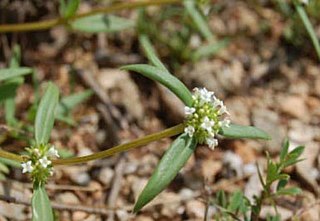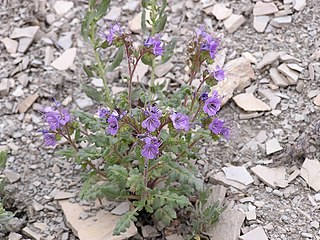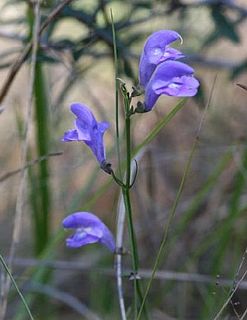
Leptocereus grantianus (sebucan) is a sprawling or suberect, nearly spineless cactus, reaching up to 2 meters in height and 3 to 5 centimeters in diameter. Its elongated stems have from three to five prominent ribs with broadly scalloped edges. Ribs of young joints are thin, and the small areoles or spine-bearing areas may bear from one to three minute, nearly black spines which disappear as the joints grow older. The flowers are solitary at terminal areoles, from 3 to 6 centimeters long, and nocturnal. The outer perianth segments are linear, green, and tipped by an areole like those of the tube and ovary. The inner perianth segments are numerous, cream-colored, oblong-obvate, obtuse, and about 8 millimeters long. The fruit is subglobose to ellipsoid and about 4 centimeters in diameter.

Quercus ilicifolia, commonly known as bear oak or scrub oak, is a small shrubby oak native to the eastern United States and southeastern Canada. Its range extends in the United States from Maine to North Carolina, with reports of a few populations north of the international frontier in Ontario. The name ilicifolia means "holly-leaved."
Chorizanthe wheeleri is a rare species of flowering plant in the buckwheat family known by the common names Santa Barbara spineflower and Wheeler's spineflower. It is endemic to Santa Cruz and Santa Rosa Islands, two of the Channel Islands of California.

Dudleya gnoma is a rare species of succulent plant in the stonecrop family known by the common names munchkin liveforever and munchkin dudleya. It is endemic to Santa Rosa Island, one of the Channel Islands of California, where it is known from one single population containing about 3200 plants. The population was discovered in the 1950s and assumed to be a relative of Dudleya greenei, a plant also occurring on the island which is similar but larger and contains the same number of chromosomes. The plant was not described to science until 1997. The population is protected from nearby grazing cattle by a fence. It still faces threats from deer, which can get past the fence, a limited gene pool, and the fact that a single severe event such as a drought, could eliminate the single population. Though rare in the wild, this dudleya is kept in cultivation by gardeners and enthusiasts of succulents, and a cultivar called 'White Sprite' is popular.

Eriogonum spectabile is a rare species of wild buckwheat known by the common name Barron's buckwheat. It is endemic to Plumas County, California, where it is known from two occurrences in Lassen National Forest near Chester. There are approximately 250 individuals in existence. It grows in scrubby, forested mountain habitat, only on glaciated andesite substrates. This rare plant was discovered in 1997 and described to science as a new species in 2001.

Catesbaea melanocarpa is a rare species of flowering plant in the coffee family known by the common name tropical lilythorn. It is native to five Caribbean islands: Puerto Rico, St. Croix in the United States Virgin Islands, Antigua, Barbuda, and one island in Guadeloupe. The plant is threatened by habitat loss.
Cranichis ricartii is a rare species of orchid known by the common name Puerto Rico helmet orchid. It is native to Puerto Rico, where it is known from three locations in one forest. The plant has also been seen in Guadeloupe. The plant's rarity is the main reason for its listing as an endangered species of the United States.

Daphnopsis hellerana is a rare species of flowering plant in the genus Daphnopsis of the family Thymelaeaceae. It is endemic to Puerto Rico, where there were only four populations remaining in 1992, with a total of 125 individuals. It was federally listed as an endangered species of the United States in 1988.

Diplazium molokaiense is a rare species of fern known by the common name Molokai twinsorus fern. It is endemic to Hawaii, where it is one of the rarest ferns. It has historically been found on the islands of Kauai, Oahu, Lanai, Molokai, and Maui, but it is thought to have been extirpated from four of them and today can be found only on Maui where fewer than 70 individual plants remain. The fern was federally listed as an endangered species of the United States in 1994.

Echinocereus fendleri is a species of cactus known by the common names pinkflower hedgehog cactus and Fendler's hedgehog cactus. It is named in honor of Augustus Fendler.
Elaphoglossum serpens is a rare species of fern that grows only on Cerro de Punta, the highest mountain in Puerto Rico. The fern grows at one location, where there are 22 known specimens. It was federally listed as an endangered species of the United States in 1993.

Cyperus pennatiformis is a rare species of sedge known by the common name coastal flatsedge. It is endemic to Hawaii, where it grows on the islands of Maui, Kauai, and Laysan. It is a federally listed endangered species of the United States.

Mitracarpus polycladus is a rare species of flowering plant in the coffee family known by the common name cana gorda girdlepod. It is native to Puerto Rico, where it is known only from the Guánica Commonwealth Forest in Guánica. It can also be found on the island of Saba. It grows in coastal scrub forest and dwarf forest with limestone gravel substrates. Other plants in the habitat include Bucida buceras, Bursera simaruba, Exostema caribaeum, Coccoloba microstachya, Plumeria alba, and Pilosocereus royenii.

Phacelia argillacea is a rare species of flowering plant in the borage family known by the common names clay phacelia and Atwood's phacelia. It is endemic to Utah in the United States, where it is known only from one canyon in Utah County. It is "one of Utah's most endangered species"; it is "one of the nation's rarest plants" and is federally listed as an endangered species of the United States.
Schiedea helleri is a rare species of flowering plant in the family Caryophyllaceae known by the common names Heller's schiedea and Kaholuamanu schiedea. It is endemic to Hawaii, where it is known only from the island of Kauai. It is threatened by the degradation of its habitat. It was federally listed as an endangered species of the United States in 1996.

Schiedea hookeri is a rare species of flowering plant in the family Caryophyllaceae known by the common names Hooker's schiedea and sprawling schiedea. It is endemic to Hawaii, where it is known only from the island of Oahu. It is thought to have been extirpated from Haleakalā on Maui. It is threatened by the degradation and destruction of its habitat. It was federally listed as an endangered species of the United States in 1996.

Scutellaria floridana, the Florida skullcap, is a rare species of flowering plant. It is endemic to Florida in the United States, where it is known only from the Florida Panhandle. It is threatened by a number of human activities and its small population sizes make it vulnerable. It is a federally listed threatened species.

Stenogyne kanehoana is a rare species of flowering plant in the mint family known by the common name Oahu stenogyne. It is endemic to Hawaii, where it is known only from the Waianae Range on the island of Oahu. It is a federally listed endangered species of the United States.

Consolea corallicola is a species of cactus known by the common names Florida semaphore cactus and semaphore pricklypear. It is endemic to Florida in the United States, where it is limited to the Florida Keys.

Alocasia cucullata is a species of flowering plant in the arum family known by the common names Chinese taro, Chinese ape, Buddha's hand, and hooded dwarf elephant ear. It is kept as an ornamental plant.

















